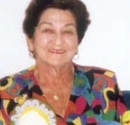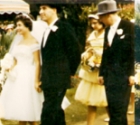
Dame Miriam Rothschild and her daughter Naomi Balaban, now a professor at Tufts University School of Medicine
There was never any question in my mind as to which fairies - or how many - had crowded around Miriam Rothschild’s cradle in the summer of 1908 at Ashton Wold, the Northamptonshire mansion in which she was born and where she lived and worked all her life. Which fairies? I would say all of them, at their most magnanimous and imaginative.
From childhood Miriam was endowed with good looks, noble birth, striking intelligence, loving parents, a fortune, penetrating and abiding curiosity about the workings of the natural world and, not least, buckets of charm. To this winning mix were added, in the course of her ninety-six years, eight honorary degrees, a cherished Fellowship from the Royal Society and the undisputed international title of Queen of The Fleas (although she was also widely acknowledged as a ranking expert on butterflies, wildflower cultivation, virtually all forms of environmental protection, art by mentally ill patients and the writings of Proust). Not bad for someone who had never gone to college. Oh, and five children (two of them adopted) and their various broods.
I can’t remember where or how we met, just that I was instantly captivated by her and that she seemed to like me. What is engraved on my memory is the first time I visited her at her home. Golda’s spotless little house betrayed nothing of the history it had witnessed and looked boring and unbeautiful like all the other houses in the row, but it was easy enough to find. Miriam Rothschild’s house, situated on a 500 acre estate, was so deeply embedded in woodlands and so thickly enveloped by a jumble of climbing plants and trees that it couldn’t be seen at all from the road and was routinely missed by all first-time visitors, myself included.
No battle with weeds was ever permitted at Ashton: everything that wanted to grow was allowed to and the result was as luxuriant and unique as the famous chatelaine herself who came striding towards me clad, astonishingly, in a shapeless mauve ankle-length silk dress, white gym shoes, her hair tucked away under a matching mauve silk kerchief, her face free of cosmetics. As always in those days, she was followed by a yapping retinue of small dogs.
As our friendship progressed, I would learn that, true to her entire way of life, she was guided in the matter of her wardrobe mainly by down-to-earth considerations, seasoned by her considerable flair for the dramatic.
She explained her unconventional garb to me one morning as we made our way to the National Dragonfly Museum she had recently founded, “Think of it,” she said, "it makes a lot of sense. I don’t have either the time or the inclination to fuss with my hair, so I cover it up. I don’t want to waste energy choosing clothes, so I just choose colors and patterns and a style that is never out of fashion because it was never in it, then I have it all made up for me and sent here. Since I never wear animal skins and therefore no leather and since I’m on the go all the time, gym shoes are perfect for me. As you see, I get around very quickly in them.”
For very important occasions, however she changed into white rubber boots...
Her efficiency was extraordinary; to lessen the burden of the entertaining she so enjoyed, the dining room table was permanently set for a dozen people and much of the great house itself was divided into self-contained suites (bedroom, sitting room, kitchenette and bathroom) for guests and family who stayed over.
It was wonderful - having at last found the house and the hostess - to discover in the rooms allotted me, an abundance of fresh flowers, best-selling books, a couple of bottles of single-malt whiskey and ditto of Rothschild wine as well as tins of biscuits, baskets of fruit and, in the fridge, the makings of a country breakfast. No instructions were issued, but it was apparent that I was expected to wash my own matutinal dishes. Other meals – and they were magnificent - were designed and presided over by Miriam. On weekends there were always guests because people, creative, significant people, vied for invitations to Ashton even when Miriam entered her nineties.
It all ran like clockwork, like a superb inn set in stunning scenery, with the minimum of staff in sight and no demands on the guests – except that they fend for themselves until lunch when Miriam took a break from her work. She worked whenever she could; even when she was very old and couldn’t walk without great pain, she whizzed around the house and estate in a state-of-the-art electric buggy, always finding time - usually at night – for her research.
But that wasn’t all, by a long shot. In a letter she wrote to me when she was 91 - on the specially ordered glossy paper she believed made writing quicker and easier - she permitted herself to complain: “…It is unimaginable how many chores have suddenly plonked down on me. New Year cards must be answered; fire alarms renewed; Catholic priests advised about sowing wild flowers; ponies shod; tax returns checked; butterflies fed; some hens purchased; the well to be retested… and tomorrow I’m supposed to go to London to my book launch and the BBC wants an interview.”
After dinner, provided she wasn’t watching tennis on TV (among other things, Miriam was an ardent and knowledgeable sports fan) she and I would talk, sometimes for hours, our chairs drawn up to the fireplace. She was interested in everything: Israel, about which she cared passionately and visited often until she had to stop travelling; literature, she was a voracious and retentive reader; people, she loved gossip - the wickeder the better - and knew every one who was anyone. We also talked in harmony and absolute candor about marriage - our own and other people’s; sex - in general and in particular; politics; the rearing of grandchildren; her own complicated upbringing and always about old age, hers and mine.
No one peeking through the window at these two old ladies chatting in the firelight could have guessed the indiscretions and confessions that made up much of our conversation, or the cause of the often rather unseemly laughter that accompanied them. But those evenings, that talk, were like a gift to me and I came to understand how aging could be, if one was lucky enough, as Miriam was, to have one’s wits about one, to be able to sift out what matters and what does not and remain part of the real world for as long as possible.
And, of course, everything would be easier if I were a Rothschild…
Rinna Samuel, editor and author, was born in London, went to high school in Tel Aviv, graduated from New York University School of Journalism and was a staffer at TIME, the NY Times Book Review, The Jerusalem Post and the Weizmann Institute of Science for many years. A sought-after ghostwriter, she has international bestsellers to her credit and clients who include at least two Prime Ministers.
 DEAR EDITOR 157 MAGAZINE
DEAR EDITOR 157 MAGAZINE COUNTING ON INFERENCE
COUNTING ON INFERENCE SHULAMIT LAMIE RAVINSKY 1925-2010
SHULAMIT LAMIE RAVINSKY 1925-2010 Bridesmaid recalls a very special day 59 years ago
Bridesmaid recalls a very special day 59 years ago Harry Berman
Harry Berman Sam Levin
Sam Levin Rinna Samuel
Rinna Samuel